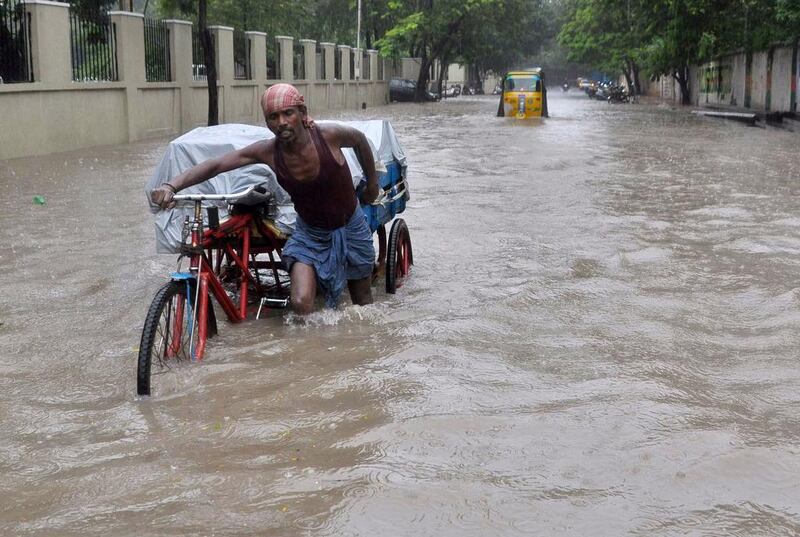NEW DELHI // Heavy rain flooded the southern city of Chennai for the second time in a month, inundating its streets, forcing cancellations of flights and trains, and bringing the army out for relief work.
On Tuesday, central parts of Chennai received 12 centimetres of rainfall, and 18cm fell on some of the city’s suburbs. Although the rain eased on Wednesday morning, forecasters predicted at least three more days of heavy rain as a low-pressure depression moves inland from the Bay of Bengal.
Chennai was also battered by rain in mid-November with 25cm of rain falling down on the city. The two spells of rain helped break a 100-year-old record for most rain received in Chennai in a calendar month, bringing the total to over 119.7 centimetres.
More than 180 people are estimated to have been killed from the two downpours and the flooding that they have caused.
Reservoirs have had to release thousands of cubic feet of water into the Adyar River running through the city, causing it to flood the slums that line its banks.
Prime minister Narendra Modi, on Twitter, promised “all possible support & cooperation in this unfortunate hour.” After the rain earlier in November, Mr Modi had authorised 9.4 billion rupees (Dh518.6m) in federal aid to help relief and reconstruction efforts.
Photographs and video showed a city in dire straits, with water waist-deep – and sometimes even higher – on most roads. In many places, roads have caved in altogether, bringing traffic to a halt.
Chennai’s airport shut down on Tuesday evening, after water levels began to touch the fuselage of parked aircraft. Hundreds of passengers remained stranded at the airport, with taxis unavailable and traffic jams delaying cars heading to pick them up.
“I was supposed to fly back to Chennai on Tuesday, but my flight got cancelled,” said Balaji Thirumalai, an executive at a renewable-energy company who had travelled to New Delhi on a business trip. “I spent the night in a hotel. They rebooked me on a morning flight, but that was cancelled as well.”
In Mr Thirumalai’s home in Chennai, his two sons have stayed home after their school closed. Internet connections are down, he said, and the street outside his home are flooded, but otherwise his house is safe.
He was uncertain when he can return to Chennai. On Wednesday morning, Deepak Shastri, the director of Chennai’s airport, announced that the airport would be shut for at least a week.
Some of his friends went through Tuesday night and most of Wednesday without electricity. The government cut power to many localities, fearing short circuits or electrocutions.
Deviprasad Viswanathan, who works at a data analytics firm, saw the electricity go out on Tuesday evening. That day, his mother was ill, with fever and a migraine. “I had to take her to the hospital across the road in knee-deep water,” he said. “Since there was no power, we had to climb back up five floors. Luckily there was a competent doctor on call.”
Nearly every shop on his street is shut, making it difficult to buy food and other essentials. “Only Ibaco, an ice-cream parlour, is open, for some reason,” he said.
Appeals for help filled social media streams. A woman with a two-week-old baby posted on Twitter that she needed rescuing because her house was filling with water. Global Hospital, flooded with 1.5m of water, sent out Twitter messages for assistance until a state government minister promised immediate efforts to move out staff and patients.
In a neighbourhood called Ramapuram, a hundred students were stranded in a school for pupils with speech and hearing impediments. Water had risen to the level of the first floor of the building.
Boats were regular sights on the city’s streets, deployed particularly to save people whose homes were in danger of flooding.
Civic authorities set up 36 relief centres on the premises of schools, and they evacuated more than 4,000 people from slums along the Adyar.
On chennairains.org, a crowdsourcing website created on Tuesday, users listed their houses and phone numbers, offering emergency shelter.
Although the rain has been unusually severe, the city has also made poor urban planning decisions that have made it susceptible to floods and damage.
Malls and apartments have been built on dry lake beds, which fill with water in the monsoon. After software firms were allotted land in the Pallikaranai marsh, apartments sprang up in the same area, and these too have suffered during this season.
A master plan for the city that was drafted in 2008, with a vision for 2026, admitted that “although several ameliorating measures [for drainage] have been implemented, they have failed to provide total relief to Chennai citizens”. Among the primary reasons, the report points out, is that illegal constructions have been allowed to encroach into drainage channels and waterways.
In a Times of India editorial published on November 17, Mark Selvaraj, a Chennai-based urban planning expert, noted that the city had spent nearly 100 billion rupees on the construction of new stormwater drains.
“But construction of these drains should be based on proper hydrological calculations, which was never done,” Mr Selvaraj wrote.
ssubramanian@thenational.ae





